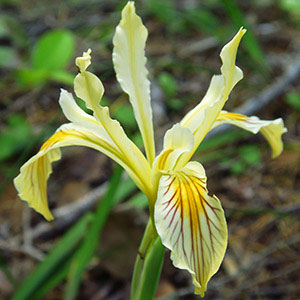Iris bracteata
Iris chrysophylla
Siskiyou iris
golden leaf iris, slender-tubed iris, yellow-flower iris, yellow-leaf iris
sheathed with old leaf bases, slender, 0.6–0.9 cm diam.;
roots few, fibrous.
compact, dark brown, slender, 0.5–0.6 cm diam., covered with old leaf bases;
roots few, fibrous.
simple, solid, 1.5–3 dm.
simple, solid, slender, 0.25–2 dm.
basal with abaxial surface of blades deep glossy green on one side of fan, light yellow-green on other side, pink or red-tinged basally, strongly ribbed, 4–6 dm × 0.8–1 cm, rigid, margins not thickened;
cauline 3–6, imbricated, closely sheathing stem ca. 2/3 length, spreading distally, bractlike, blade inflated, often shorter than basal leaves.
basal with blade light green, pink or red-tinged basally, finely ribbed, linear-acute, 2.5–5 dm × 0.3–0.5 cm, somewhat glaucous, margins not thickened;
cauline 1–3, imbricated, blade bractlike, inflated.
simple, units 1–2-flowered;
spathes closed tightly around pedicel and ovary, lanceolate, 5.2–9 cm × 6–8 mm, subequal, herbaceous, margins scarious, apex acuminate.
usually 2–flowered;
spathes sometimes flushed pink or purple apically, lanceolate to linear-lanceolate, 5–10 cm × 3–7 mm, unequal, outer much shorter and narrower than inner, herbaceous, margins often scarious, apex acute.
perianth cream to buff-yellow;
floral tube 0.8–0.9 cm;
sepals with deeper yellow signal, veined with purple or brown, obovate-lanceolate, 6.5 × 2.5 cm, base gradually attenuate into wide claw;
petals narrowly oblanceolate, 7–9 × 0.8–2 cm, base gradually attenuate;
ovary nearly circular in cross section, 1.5–2.5 cm, base gradually attenuate into pedicel, apex abruptly acuminate into floral tube;
style 2.2–3 cm, crests spreading, yellow, not veined, 1.2 × 0.9–1.7 cm, margins toothed;
stigmas triangular or tongue-shaped, margins entire;
pedicel 3–6.2 cm.
perianth cream or very pale yellow, with deeper yellow or lavender veins;
floral tube linear, slender, 4.5–12 cm;
sepals with bluish tinge and veins, oblanceolate, 4.6–7 × 1–2 cm, base gradually attenuate;
petals lanceolate, 3–5.5 × 0.6–1.2 cm, base gradually attenuate, apex emarginate;
ovary 1–1.8 cm, base abruptly attenuate into pedicel (when present), apex gradually acuminate into floral tube;
style 2–3 cm, crests 1.5–2 cm, sometimes exceeding arms, apex narrowly pointed;
stigmas tongue-shaped, margins entire;
pedicel absent or 0.5–1 cm at anthesis.
nearly circular in cross section, tapering abruptly at each end, 2–2.5 × 1–1.5 cm.
sometimes on elongated pedicel, oblong, round in cross section, sharply beaked, 2–3 cm.
dark brown, irregular in shape, wrinkled.
buff, slightly compressed.
= 40.
= 40.
Iris bracteata
Iris chrysophylla
Iris bracteata is limited to one county each in northern California and southern Oregon. It hybridizes with I. chrysophylla, I. douglasiana, I. innominata, I. munzii, I. purdyi, and I. tenax.
(Discussion copyrighted by Flora of North America; reprinted with permission.)
Iris chrysophylla hybridizes with I. bracteata, I. douglasiana, I. innominata, I. macrosiphon, I. purdyi, I. tenax, and I. tenuissima.
(Discussion copyrighted by Flora of North America; reprinted with permission.)


